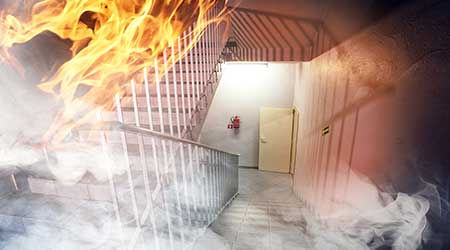For Fire Safety Systems, Going Beyond Code May Pay Off
Incorporating technology like addressable notification systems and wireless alarm systems may reduce overall costs over the life of a fire safety system — and make for a better overall system, as well.
It is important for building owners to understand the exposure that can result from poor fire protection planning. Delays during plan review are mere inconveniences compared to the reality that something as substantial as an on-site water storage tank for suppression systems or increased fire hydrant flow will be required. And remember that all model codes require fire protection and life safety features to be in place and functional prior to a certificate of occupancy (even a temporary certificate) being issued.
The design phase of a renovation or new construction project should include a review of the benefits of going above and beyond the prescriptive code requirements for fire and life safety systems. A few examples include increasing the design criteria of sprinkler systems, increasing the fire rating of a separation wall, subdividing a building into smaller fire areas, or providing smoke exhaust systems; by taking steps like these, the building owner may recognize a savings in insurance premiums if the underwriter identifies the level of risk to be greatly reduced. There are savings that are realized due to the lower likelihood of property damage and business interruption, which in the lifetime cost of the building could tip the scale to encourage building owners to spend the extra money during construction to go above and beyond code minimums.
The use of new technologies, such as wireless fire alarm systems or addressable notification devices, generally goes beyond minimum code requirements; however, these types of systems will reduce the costs associated with the testing, maintenance, and inspections required throughout the life of the system. A system with minimal wiring, or one that can self-monitor device integrity, will greatly reduce the labor hours spent troubleshooting, and the inspection process can be streamlined by reviewing the report of notification devices, rather than visually inspecting each device. The added costs of these features can be justified as long as building owners are looking at the lifetime costs associated with each system, and not just the construction costs.
Whether it’s new construction or renovation, involving knowledgeable and qualified fire protection engineers and consultants at the conceptual phase will not only aid in planning, but will also reduce unexpected project costs.
The building systems and construction features that are required by the codes are based on many “if-then” conditions. These require the review and oversight of qualified architectural and engineering professionals with the ability to filter through all the layers of decisions, as well as to demonstrate potential trade-offs that will reduce or eliminate costly changes to the project. It is less costly to make necessary changes during the design process than during the inspection process. It also reduces the effect on the construction schedule and allows the building owner to properly budget for the project, rather than being forced to pay for additional systems when the project is well underway and the budget is already stretched thin.
Drew Gerard (dgerard@telgian.com), PE, CFPS, is the MidAtlantic fire protection engineering practice leader for Telgian Engineering & Consulting. His fire protection and life safety expertise spans a wide array of sectors such as healthcare, educational, large retail, commercial, and industrial.
Related Topics:














